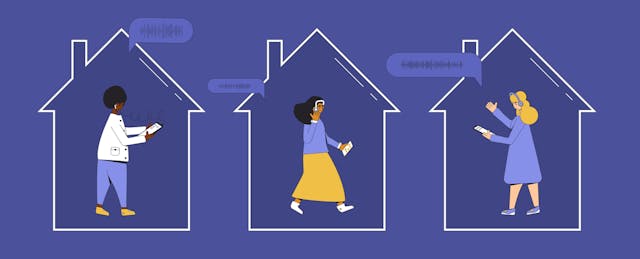Assistant Principal Ronda Smith remembers her heart racing when she learned that John F. Kennedy Middle School would pivot to remote learning because of the pandemic.
“We didn't have the tools or the training,” explains Smith. “This was going to be a challenge, and if we didn’t get it right, it could literally set us back in our efforts to move forward.”
Her Title I school in Riviera Beach has a growing population of English language learners. Many students also have significant deficits in reading comprehension, literacy and foundational math skills.
The district put devices and wi-fi hotspots in students’ homes, which was a triumph. But, Smith wondered how teachers could make classroom best practices and strategies work in a virtual world. It turns out that grit, compassion and help from Pear Deck’s digital learning platform were the right combination for Smith and her colleagues.
EdSurge talked with Smith to learn how Pear Deck empowers teachers, amplifies student voice and supports engagement.
EdSurge: Describe the challenges you faced as you moved online last year. How did Pear Deck help you overcome them?
Smith: I have to commend our district; they were able to get every child a device and hotspots. But to be honest, since budgets were locked in, there were no funds for additional resources. We had to figure out how to get students engaged online, which was already a focus in the brick-and-mortar setting.
Many of our kids come from low socioeconomic backgrounds. The pandemic had a huge impact on our students and their families, causing a shift in priorities, including education. They're worried about getting food on their tables, job security and housing.
Now, we’re talking about a teacher with a screen, a student with a screen, and they’re miles apart. How are we supposed to have this interaction with students?
That’s when our reading coach, who came to us from our district’s virtual program, suggested Pear Deck. She was already using it with her students.
Teachers can take a slide presentation they already have and quickly convert it to a Pear Deck lesson. Then, they present the lesson and engage students with questions or quick formative assessments (like exit tickets)—even send feedback to students privately if they need help. Pear Deck allowed schools to use their platform for free because they understood that education must continue. It was genius.
What was that transition like for teachers?
If you look at our data, 38 percent of our teachers are novice teachers, anywhere between their first and third year. However, about 39 percent have been teaching for seven years plus, and some of those teachers often have a bit more difficulty with that technology piece. We needed something simplified, something they could master quickly and use from here on out. That’s what Pear Deck provided us.
Let me share an example. I have this one reading teacher, and he is wonderful, lively and passionate about what he is teaching. But when we announced we were switching to virtual learning and Pear Deck, he expressed thoughts about retiring. There was just so much change happening all at once. We talked about how much our kids needed him, and he decided to give it a try with some modeling and support from his team leader and administrators. Let me tell you, about a month after us going virtual, I popped into his classroom, and he was maneuvering this program like no other. I was floored—in tears.
Now that we’re in a hybrid learning setting with 60 percent of our students attending remotely, we can't function without Pear Deck. The teachers emailed me, frantic because their trial was ending, and they wanted to continue using the program. So when our new budget rolled over, my principal purchased the program.
How does Pear Deck support you in your role as an administrator?
My main concern as an administrator is how we are tracking student progress. It’s great that you're teaching, but how are you monitoring for understanding and mastery? There has to be some type of checkpoint. You can't just teach with a PowerPoint and think that your kids are getting it.
With Pear Deck’s Teacher Dashboard, you can see that the kids are completing problems and answering questions, whether working synchronously or asynchronously. You can also see when they’re not so that you can redirect them. When it came to bridging that gap and getting students engaged with virtual content and instruction, Pear Deck was the key. It gave us that opportunity to redefine what those instructional practices would look like now that we are in this virtual world.
What other positive impacts have you observed since the move to virtual instruction?
Because of Pear Deck, we didn’t lose much ground with our kids. We continue to effectively use strategies and best practices that we know work with our kids. It's been essential. It's what helped us increase student engagement and continue with instruction during this shift in education. It gives the students a voice in a virtual world.
Our ELA and reading teachers use Pear Deck with fidelity. For literacy, especially, we use strategies such as marking the text. The kids can circle key vocabulary and underline textual pieces of evidence. They can annotate on the side of the text. That’s exactly what they would be doing in the classroom if they had the paper in front of them. Now we’re virtual, but they can still do that and have those same skills reinforced. It looks different, but there is no loss. The students surprisingly prefer to do it online anyway.
It empowers teachers with a tool that helps them become highly effective in the classroom. They can deliver clear, concise instruction using best practices like guided instruction and independent practice with students. Then, you have this data sitting there, and you can't ignore it. If the kids responded to a problem or set of questions, and 50 or 60 percent got it wrong, the teacher knows, “I need to stop and go back over this.”
You can have that in this virtual world with Pear Deck. It’s user-friendly, and anyone from a novice teacher to a veteran teacher can use it.



